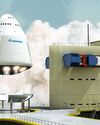
Earth has a problem, at least if you want to train astronauts. It’s called gravity, and while useful for things like attaching your feet to the ground, it’s an inconvenience when you need to acclimatise people to weightlessness. So what do you do? If you’re a national space agency, you set up a special flight that takes advantage of free fall to simulate the weightless experience.
In order to simulate a feeling of weightlessness like astronauts experience once free of Earth’s gravity, the aircraft flies a particular flight path. It climbs at an angle of 45 degrees to altitude before nosing over and descending at 30 degrees in a parabolic path relative to the centre of the Earth, using just enough engine thrust to cancel out the drag of the aircraft moving through the air. During certain parts of the flight, the aircraft and all aboard it are in free fall and experience weightlessness. This begins while the craft is still ascending, continuing while it passes the peak of its climb and begins to descend, until the pilot is forced to pull up on the stick to climb again and avoid hitting the ground. For each parabola, passengers and crew experience around 25 seconds of weightlessness, and a flight is likely to carry out 40 to 60 such manoeuvres.
The idea goes back to 1950, when it was proposed by German brothers Heinz and Fritz Haber, a physicist and aerospace engineer respectively. They had been taken to the US as part of Operation Paperclip at the end of World War II, where they undertook pioneering research in space medicine and worked with Wernher von Braun. Heinz would also collaborate with Shih-Chun Wang, a Chinese-American doctor studying nausea in astronauts for NASA, on the creation of the Vomit Comet.
Diese Geschichte stammt aus der Issue 118-Ausgabe von All About Space.
Starten Sie Ihre 7-tägige kostenlose Testversion von Magzter GOLD, um auf Tausende kuratierte Premium-Storys sowie über 8.000 Zeitschriften und Zeitungen zuzugreifen.
Bereits Abonnent ? Anmelden
Diese Geschichte stammt aus der Issue 118-Ausgabe von All About Space.
Starten Sie Ihre 7-tägige kostenlose Testversion von Magzter GOLD, um auf Tausende kuratierte Premium-Storys sowie über 8.000 Zeitschriften und Zeitungen zuzugreifen.
Bereits Abonnent? Anmelden

MYSTERIES OF THE UNI WHERE ARE ALL THE SPIRAL GALAXIES?
There are far fewer spiral galaxies than elliptical ones in the Supergalactic Plane, and scientists are keen to discover why

ZOMBIE STARS
+10 OTHER TERRIFYING SPACE OBJECTS

HOW TO BEAT LIGHT POLLUTION
Thought it was impossible to observe the wonders of the night sky from towns and cities? Think again. Follow our tips and tricks on successfully observing through sky glow

15 STUNNING STAR CLUSTERS
These beautiful stellar groupings are spattered across the cosmos

Eileen Collins "It was a difficult mission...we were the first to see Mir"
Having served as both the first female pilot and first female commander of NASA's Space Shuttle, Collins boosted the involvement of women in space exploration to a whole new level

MARS LEAKS FASTER WHEN IT'S CLOSER TO THE SUN
The Red Planet has lost enough water to space to form a global ocean hundreds of kilometres deep

FUTURE TECH KANKOH-MARU
This ambitious reusable spacecraft will be capable of taking 50 people to and from orbit

THE FINAL FRONTIER
Beyond the reach of the Sun is a fascinating region of the cosmos that were only just beginning to explore

A long-lost moon could explain Mars' weird shape and extreme terrain
A long-lost moon could explain why Mars is so different from the other rocky planets in the Solar System. Today Mars has two tiny moons.

A sprinkling of cosmic dust may have helped kick-start life on Earth
Cosmic dust may have helped kick-start life on Earth. New findings challenge a widely held assumption that this wasn't a plausible explanation.